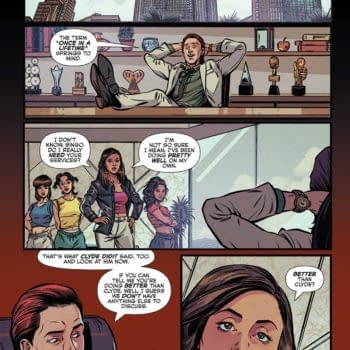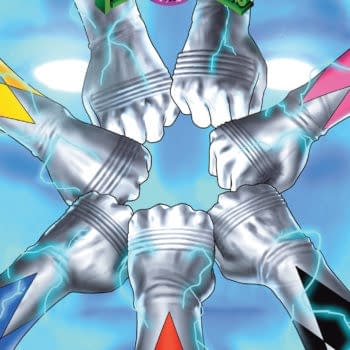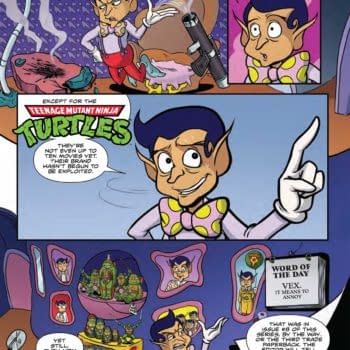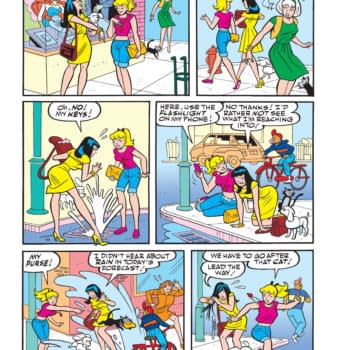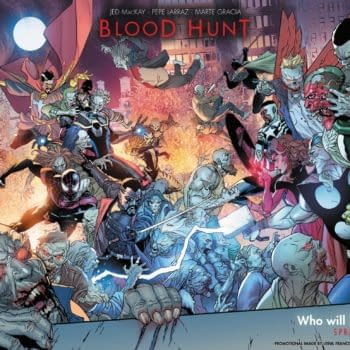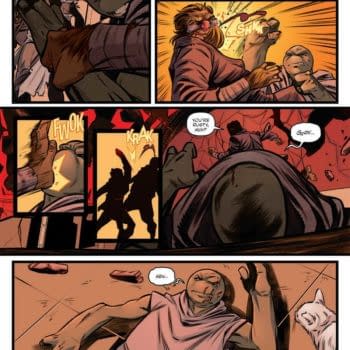Posted in: Comics, Recent Updates | Tagged: All-New Hawkeye #1, Comics, Descender #1, entertainment, image comics, Lazarus #15, Marvel Comics, Miles Morales: Ultimate Spider-Man #10, miracleman 15, princess leia, Sex Criminals #10, Spider-Woman #5
Thor's Comic Review Column – Descender #1, Spider-Woman #5, Princess Leia #1, Sex Criminals #10, Lazarus #15, Miles Morales: Ultimate Spider-Man #10, Miracleman #15, All-New Hawkeye #1
This Week's Reviews:
Descender #1
Spider-Woman #5
Princess Leia #1
Sex Criminals #10
Lazarus #15
Miles Morales: Ultimate Spider-Man #10
Miracleman #15
All-New Hawkeye #1
Descender #1 ($2.99, Image)
By D.S. Randlett (@dsrandlett)

Jeff Lemire and Dustin Nguyen's Descender follows quite a few trends in terms of its genre and its trace of influences, but it acquits itself on either performing old tricks extremely well or else by integrating influences that you don't see in many SF comic books. In comics, the field of influence tends to be from pulpier fare that features a lone, heroic frontiersman braving weird obstacles in a dirty "used future" setting. In Descender, Lemire and Nguyen pull from Utopian SF like Iain Banks' Culture series to open by presenting a society that seems to pretty much have its shit figured out. People seem to live lives without too much deprivation, and mechanical consciousnesses are granted some semblance of rights (though it is unclear as to whether or not they are as full as in Banks' visions).
Without spoiling too much, it suffices to say that this Utopia suffers a major cataclysm, which throws society into tumult. There are robot purges in several places in the galaxy, and there are cities in which as many as 4.5 billion have died, spread across entire worlds. Amid all this, we get to see a couple of different points of view in the effort to discover what cause the cataclysm, a desperate robotics scientist living in the capital city of this galactic civilization, and a lone robot living on a secluded outpost who may well be the key to unlocking the mystery of the cataclysm. It's a unique story to SF comics in that, as yet, there's no great enemy to fight, but a problem to be solved.
The keystone to Descender is easily Dustin Nguyen's gorgeous watercolor artwork. It's some career best work, and contributes to storytelling on just about every level. The layouts are well thought out, certainly, but it's the sheer artistry in the composition of every image that really impresses and evokes the themes and feelings in the narrative. While much of the events that transpire carry dark tidings, Nguyen gives the proceedings something of a lighter, more tender touch. In certain sections of the story, this is absolutely essential, and goes a long way in selling the humanity of certain nonhuman characters.
It's a bit early to tell if the hype surrounding Descender is deserved. Given the talent involved, it's likely, and I can't wait to see what this series looks like as it's completed. This first issue alone represents a vision that is solid, and concrete. Hopefully, it keeps holding together.
D.S. Randlett lives in the hills of Virginia and takes credit for the reviews that his emaciated twin brother writes while chained to the old radiator. He plays his guitar while biding his time for unsuspecting tourists and thinking about going to grad school.
Spider-Woman #5 (Marvel, $3.99)
By Graig Kent
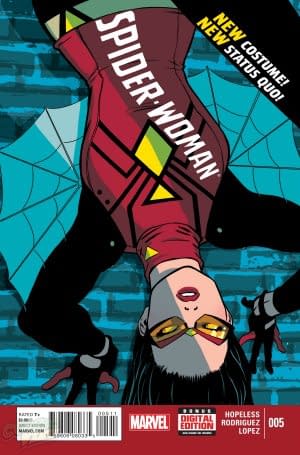
Half a decade later, this new series was at best mildly anticipated by Spider-Woman fans, the first disappointment being that it was launching as a tie-in to "Spider-Verse". Launching a title as a tie-in to an event in part excludes potentially interested readers who are not engaged with the event (like myself). As well, having the event be the driving thrust makes it harder to establish the status quo for a new series and its character.
The next disappointment came with the creative team announcement. Dennis Hopeless had proven himself a dependably solid writer, coming out of a potentially disastrous Avengers Arena smelling like roses, ably juggling high concept and a large cast, showing a particular aptitude for character development. Hopeless actually wasn't a problem, and in fact I expected he would likely be a good match for the Jessica Drew. Notorious pornstar referencer Greg Land's name in the credits, however, seemed like a huge step back for a female-led title. The days of general fandom getting excited over butt-shots and nonsensical posing in a mainstream book are over. This isn't the '90's. Quality characters, meaningful stories, and smart (not lascivious) illustration is the desired status quo. After that, whatever goodwill remained towards the series was eaten away by one now infamous cover from legendary eroticist Milo Manara. If you read this site, you know the one. I don't need to go into detail.
I haven't looked at the numbers, I can't tell you how the first four issues did after the hubub and furor of "butt-crevasse-gate" or whatever its been dubbed (I stopped paying attention due to butt-crevasse-gate fatigue), but given the prompt retooling in only its fifth issue, the response was decisive and relatively swift by Marvel to change things, and change them for the better.
With issue 5, Land is off the book, replaced by Javier Rodriguez, whose style couldn't be more different. Where Land relies heavily on photo-referencing for his characters, to the point of distraction, and is big on real-world detailing, Rodriguez is much more a classic comic book illustrator in the Marshall Rogers vein, somewhat cartoony, less concerned with exacting detail and more interested in conveying a scene dynamically. The opening sequence of the book finds Jessica Drew fighting in the rain in her new duds (which is a motorcycle jacket, stylized glasses and stretchy pants rather than the spandex onesie with an emblem that, over the years, came to accentuate her bosom) while bulk of the book puts her in plain clothes (really just the same wardrobe without her leather jacket) interacting with non-spandex types. While Rodriguez handles the action with an exciting playfulness, he rather excels at the talking heads. Handling his own colours, they likewise stand out, as he uses them to create some dramatic and intriguing lighting effects that really set the atmosphere of the scene..
As expected, Dennis Hopeless is an excellent fit for the character. Jessica Drew is a flawed character, one prone to getting caught up in the excitement of a chase or fight without always fully assessing the scene. She's never really felt like a Spider-Man analog, the way Supergirl and Batgirl can often feel; she's not really a big part of the Spider-Man universe as she's always been out on her own, well-distanced from him, feeling connected at best thematically. Her identity is in no way dependent on Peter Parker and Hopeless perpetuates that here. He brings in Ben Urich as a supporting character, rather than someone more connected to her past as Avenger or S.H.I.E.L.D. agent, or someone from the Spider-verse. Like She-Hulk, she feels more at home operating in her own distinct realm rather than sharing any significant part of a venn diagram with her male counterpart.
This radical new costume was no doubt inspired by DC's massively successful revamp of Batgirl. However whereas Batgirl likewise radically shifted Barbara Gordon's character into new setting with a wildly different storytelling style, this doesn't seem that drastic a shift for Jessica Drew's character. The tone of the book is going for something more akin to the recently concluded She-Hulk, Hawkeye or The Superior Foes of Spider-Man (which may spell doom for its longevity), being an even mix of action, character development and humor while still recognizably operating in the Marvel Universe (whereas Batgirl feels more than a step removed from your average DC book).
I have to say, I've long been fond of Spider-Woman and her costume (I've preferred Spider-Woman to Spider-Man since I was a little kid), so I wasn't expecting this change to appeal to me. I suppose the change was necessary but it seemed a little too reactionary (primarily to Batgirl). As well I wondered why bother revamping the book, why not just make "Spider-Gwen" the new star of Spider-Woman instead? Ultimately I'm more than pleasantly surprised, with the costume, the art, the characterization and storytelling. With She-Hulk, Hawkeye and Superior Foes ending, this fills that story-style void quite nicely, It's playful without being too goofy, and explores the Marvel Universe from unique vantage point. It's still a book about heroes and villains but going about it its own way.
This actually feels like a proper first issue. Just take the preceding "Spider-Verse" storyline as a mini-series that made way for the ongoing.
Princess Leia #1 (of 5)(Marvel, $3.99)
By Graig Kent

It's not that I am in any way begrudging there being a Princess Leia book. As I read the first two issues of both Marvel's Star Wars and Darth Vader to my daughter, she would see the ad for Princess Leia and be most excited for that. Women are direly underrepresented in the Star Wars movies with literally only two main female characters across six feature films, and even then there's not a lot of time to focus on their stories. For Princess Leia, there are countless questions and items of curiosity about her and her background. Like what exactly is she the princess of? Was she still a princess after Alderaan was destroyed. Why do we never see her react to the loss of her planet or people beyond her initial horror? What happened to her father, Bail Organa, who was key to helping establish the Rebellion (and a prominent character in the prequels)?
Under Mark Waid's able guidance, these answers and more are found in this new mini-series, where he's tasked with expanding Leia's story while also course correcting some of A New Hope's more prominent failings, such as diversity and forethought.
Picking up immediately after the end of Episode Four, the opening page is literally the end of the medal awards ceremony (one thing Waid doesn't explain is what exactly Luke and Han are being awarded for. Blowing up the Death Star? Rescuing her? Both?), following which is the crowd (and Luke's) reaction to Leia's cold demeanor and lack of addressing Alderaan's fate. Even General Dodonna's getting on her case about it. Leia, as we all know, is a strong-willed character — she survived Vader's interrogation droids without getting a hair out of place in her buns, and she choked out Jabba the Hutt like she was getting her crossfit workout started — she's not going to be crippled with grief or coddled, as she seems to have to remind everyone except Artoo in this book. Leia wants to help, she wants a mission, she wants to fight, not wallow in sorrow, and regardless of what the General says, she's going to do what she wants. It's when she hears that that Imperials are hunting down surviving Alderaanians that she knows what she must do.
Recognizing that Star Wars is a massive sausage fest, Waid introduces Rebel Pilot Evaan, a statuesque blonde female (disappointing that she's yet another white character when she could have been literally anyone) in an X-wing fighter jumpsuit. She's an Alderaanian royalist and takes issue with Leia's demeanour about her home planet. She lives to serve Leia, but doesn't like her very much. Naturally, Leia recruits her to help her with her mission, and we see her put her pilot skills and intellect to good use.
There's a few things jarring about this first issue, chief among them being the burdensome patriarchy of the Alliance. Where I always saw Leia as a valued leader, working under Dodonna's command, the book posits it as a more familial relationship, with Leia's actions being that of a rebellious teenager instead of a credited Rebel Alliance leader. Another jarring aspect is the fact that we have two female characters actively engaging one another, something we never see in the films, ever. Leia and Evaan's interactions are so outside of what's normal for Star Wars (not that it's "girl talk" but rather that it's focus is largely on Leia and Evaan's feelings and thoughts, feeling more Frozen [complete with "Ice Princess" references] than The Force). It's not that Princess Leia's story is bad, just that it places the character in a light which we never got to see her in live action and it's a little difficult to resolve.
I've been reading comics featuring Terry Dodson's art for two decades now, and I'm disappointed to say this isn't his finest work. The cover image is more what I'm used to, with strong lines and expressive physicality. His interior work, inked by Rachel Dodson, seems hurried, often messy. The Dodsons capture the known sets and wardrobes well, but when it comes to the side scenes that take place in new areas, or new designs for ships or tech, they really don't seem to fit (the ship Leia and Evaan depart in is particularly out of synch with the Star Wars vehicle style). At times Dodson presents a really confident image, but for the most part the characters and their expressions seem uncertain. Particularly Dodson's Leia looks pouty or worried, demure, which is something she's never in the films, even on the end of Jabba's chain she looks full of resolve, just biding her time. If the book is a let down, it's that the image here doesn't reflect the character we know. Beyond that, the Dodson's don't hard-line Leia or Evaan's lips, leaving colorist Jordie Bellaire to paint them in and it creates an odd effect throughout.
The next issue presents another confident Dodson cover, Leia and Evaan standing in a Naboo entryway with Artoo at their side, blasters drawn. It's an image bristling with excitement that hopefully the story and art can pay off.
Graig Kent is stumping on social media for people to watch the Parallels pilot on Netflix. It's like the jumping-betwixt dimensions of Sliders meets the weirdo mysteries of Lost. Let's make this a series by watching the pilot and telling more people about it. He has no stake in it, he just enjoys good sci-fi TV.
Tying Up Loose Ends – A Round-Up Featuring Sex Criminals, Lazarus, Ultimate Spider-Man and Miracleman
By Adam X. Smith
Well, at the end of last week's column I jokingly said that if I state the intention of writing up a book featuring a title made up of leetspeak being re-releases by independent publishers for a third week in a row, maybe my copies of Ultimate Spider-Man and Miracleman and the already late Lazarus and Sex Criminals would arrive at the same time. Either Royal Mail have started recruiting the pre-cogs from Minority Report or the Tao responds really well to reverse psychology and passive aggression. Either way, I've got a bumper selection of books this week. That's the good news.
The bad news (depending on whether or not you enjoy my writing, I guess) is that due to the cumulative pressures of writing a dissertation, as well as essays and planning performance pieces for my third year degree, plus the fact that I'm getting married in less than a month's time, this is going to be the last time I'm able to write up anything on a weekly basis for the foreseeable future, barring the odd one-shot or graphic novella if I'm lucky. So for all the people who enjoy my ramblings, and even the ones who don't, prepare to get your money's worth – it's potentially the last you'll see of me for quite some time.
So let's move on.

The chapter title, "Alone Together", is very indicative of not only the above plot points but also the emotional arc that has been working itself out over the last five issues. Jon and Suzie, whilst semi-reconciled after their post-honeymoon spat, are still emotionally cut off from each other in a way that is not easily remedied. Jon, in session with his psychologist Dr Ben, comes to the realisation that he is in fact in love with Suzie, and spends the rest of the issue trying to put his fears and insecurity about intimacy aside in order to tell her so – in the end, he comes close, but chickens out.
Meanwhile, Suzie's roommate and confidante Rach is getting closer to Suzie's "pussy doctor" Robert Rainbow (who apparently is practically a monk sexually but seems to get a kick out of delivering babies – what's not to love?), and after making contact with former porn-star Dr. Ana Kincaid in the previous issue and Jon and Suzie revealing to her their shared secret ability to alter the fabric of time by orgasming, they determine to perform a field test of their abilities at a motel with a suspiciously specific billboard, in order to combat the continued threat posed by the Sex Police. However, given that Ana's ability to achieve orgasm is complicated by a childhood injury, this means she requires full body stimulation. Lots of it. And Rach and Robert are brought along for reasons. The end result… well, that would be telling. And also pretty damn graphic, all things considered.
The details of the plot, whilst not insubstantial, are probably less important by themselves than the cumulative effect of them layered on top of each other like so much writhing flesh in an orgy. The writing by Fraction continues to be gut-wrenchingly funny but shot through with moments of pathos as these damaged people gravitate into each other's orbits, and Zdarsky's artwork remains immersive and detailed whilst finding the sweet spot between humour and drama, as well as showing that you can draw sexually attractive characters in comics that aren't built like supermodels or pro-wrestlers – the variety of body types on display is almost unheard of in contemporary comic books, and none of them look any worse for it.
Also, I'm officially calling it that Jon's psychologist is actually his future self who has figured a way to travel back in time using the power of masturbation. Or else he's his actual biological father. Maybe. I'm probably way off-base, but as a Taoist they look far too similar for me to rule it out as merely coincidence.
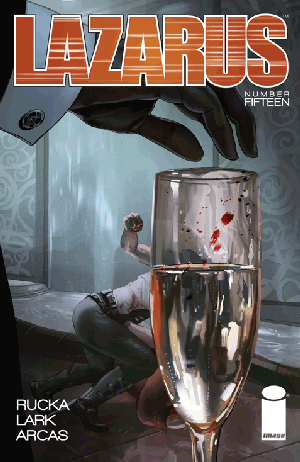
Of course, this is a transparent attempt by Hock to pit two potential allies in a war with him against each other and create a no-win situation, and his demand that should he win the trial Forever will become his personal property indicate ambiguous sinister motives regarding her. Greg Rucka sets up the stakes efficiently in a few short exchanges of dialogue, but it is Michael Lark's artwork that takes centre stage this issue, particularly during the fight proper, and after some apprehensive circling the two warrior women get down to brutal business.
The fight reminds the reader of a few things that are sometimes overlooked in the book's usual dealings: Lazari are tough, trained from infancy to be functionally immortal human weapons, but they're still flesh and blood and feel pain like anyone else, and when two of them are fighting each other on equal terms, it is a sight to behold. Lark brilliantly captures (without the aid of dialogue) the desperation and fear of these two women fighting for their lives whilst the families they are sworn to protect watch idly from the sidelines.
As I predicted previously, after a bloody fight, Forever spares Sonja the killing blow, and the arbiter concurs that nowhere in the rules does it say that one opponent must be killed by the other. However, in a spiteful move, Hock dismisses the authority of the conclave, declares open war on the Carlyle family, and spits a poison capsule in patriarch Malcolm Carlyle's face, killing him.
This was an unexpected turn for a series that has kept Malcolm relatively in the background. As both a character and a "father" to Forever, he is distant and Machiavellian, but with recent issues had shown at least some semblance of affection for her; even Jonah admitted that in spite of her being a cloned daughter raised specifically in the interests of protecting the family, Malcolm still loves Forever more than his own biological children. What's more, it comes almost completely unexpectedly, and as twists go the closest comparison would be if Tywin Lannister had took a crossbow bolt to the face halfway through season 2 of Game of Thrones. Or Gendo Ikari getting bumped off after 10 episodes of Evangelion.
For such a powerful figure to be so publicly and ignominiously dispatched, at what seems a relatively early stage in the series' life-cycle, puts both the future of the Carlyle family and the comic itself in a state of flux, creating a power vacuum that is not easily filled. The presumed frontrunner for new head of the family is Johanna, who Forever has already been tipped off by Jonah as being a manipulative schemer. Jonah himself was last seen in a life-jacket, floating away from Triton One in the middle of the North Sea – only time will tell what the future holds for Lazarus country.
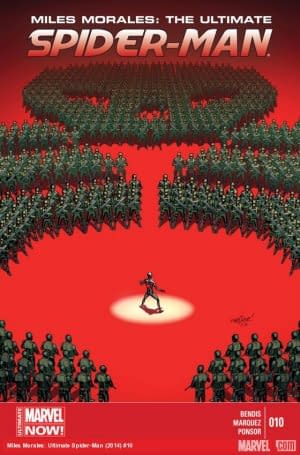
So with the threat of Norman Osborn off the table for the moment and his other baggage more or less taking care of itself, Miles has decided it's time to bite the bullet and go talk to Kate, against the advice of best friend Ganke and fellow superhero Cloak (who doesn't like her for some reason). For a kid who has recently faced off against the Green Goblin, you'd think that meeting your girlfriend's parents would be a walk in the park for Miles at this point. But then on the other hand, most people's parents aren't secretly agents of Hydra. Oy vey.
Brian Michael Bendis and David Marquez have been nailing the hell out of the soapy side of Miles Morales: Ultimate Spider-Man for a good long time, to the point where the superheroics have often felt like they're playing second fiddle to the relationship plots. In truth, though, that's always been the principle strength of most good Spidey stories – we attach greater personal investment to stories where Peter and now Miles as well have problems comparable with our own.
On the other hand, though, the pace of the series of late has been one of fits and starts, being made up primarily of slow-burners focusing on the emotional arcs, and whilst the cliffhanger ending sets up a confrontation between Miles and the (possibly) combined forces of Doctor Doom and Hydra, they really don't have a lot of room to breathe on this – the current run of Ultimate Spider-Man seems to end with issue #12 before Secret Wars mashes the continuities together for a massive multiversal blowout.
That's two whole issues with still many remaining questions on the hook – what is going to happen between Miles and Kate? What does Doctor Doom have in store for him? Did Ganke ever get to buy and build the Lego Millennium Falcon he so desperately wanted? Where have Jessica Drew and the other disbanded SHIELD agents been all this time? Is this meant to be the WWII era Hydra or the more recent redneck splinter group Spidey fought with the Ultimates during the "Divided We Fall" arc? Does Ultimate Kate Bishop ever become Hawkeye?
So many questions, so little time.
I'm not too worried – Bendis has been juggling multiple books in multiple continuities for a while now, and whatever he has planned for Miles down the line, I'm sure I'll still be invested in it. But I do find myself staring down the endpoint of this series with no small amount of trepidation, and with the Ultimate universe set to implode following the events of Secret Wars, it's both fascinating and terrifying trying to guess who will survive the fallout of yet another apocalypse.
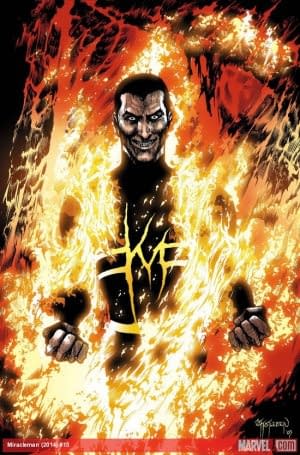
Miracleman and his comrades arrive too late to save London from the destructive power of the reawakened Johnny Bates, aka Kid Miracleman, who now resembles a genocidal Black Adam; all that remains is to put the monster down before he does further damage, and no holds are barred as they battle across time and space, throwing everything the have at each other until only one remains.
The narration from Miracleman's point of view gives an intriguing and horrifying look into the mind of a being who is truly Nietzschean in his worldview pitted against an unstoppable omnicidal maniac – at one point he says that he could lie to himself (and by extension the reader) by saying that a car that he flings at Bates was empty, but that it would be untrue; this fact, combined with the gory desolation of London, makes the final battle from Man of Steel, itself judged to be indifferent to the plight of the civilians caught in the middle, look like a cartoon by comparison.
Ultimately, it is cold efficient logic that beats the demon, as Warpsmith Aza Chorn sacrifices himself to wound Bates enough to make him transform back into his vulnerable human form, and Miracleman tearfully breaks his former protégé's neck whilst cradling him in his arms amidst the ruins of a modern holocaust.
The fallout of this story is one that doesn't quietly fade away – in the denouement, set two years later, London is still a desolate wasteland, and Miracleman is left to ponder a world that now knows that gods walk among them. There is no attempt at reclamation, no memorials, no quiet parks built to honour the dead -only an endless landscape of rubble and the bones of thousands of eviscerated people, acting as a grisly reminder of the destructive power and inhuman cruelty of even a single metahuman let loose on a major city. The age of miracles is upon us, but what that means for the future of the human race is left uncertain.
Part of me is almost glad that issue #16 didn't arrive on time, even though it supposedly serves as an epilogue to this arc. There is only so much nihilistic dread a single person can absorb in one sitting, and Miracleman #15 deals it out in spades. Moore talked in the 1980s of the cognitive dissonance present in contemporary Western culture, especially regarding comics, where extreme but bloodless violence is perfectly acceptable but portraying anything close to realistic violence, sex and politics was considered taboo, in what he described as "the Rambo mentality". Indeed, comics still live in the long dark shadow of his work; that it still has the power to fascinate and terrify thirty years on is a testament to his grasp of a fundamental aspect of realism that many modern comics still lack or choose to ignore.
The main thing that seems to irritate [critics of my work] seems to me to be political, in that they want us to show superheroes and other comic characters as perpetual boy scouts. They don't want us to show a world in which authority can ever be corrupt, or in which anything ever goes wrong. And the main thing that they cite as a reason for this is the small and vulnerable minds of children… Basically, my feeling is that the world which we have been careless enough to leave lying around for our children to inherit is a place which is sometimes hostile, which is sometimes dangerous, which has got a lot of very frightening edges to it. And the only way that I can help my children, the only real way I can give them of securing their emotional and physical and psychological survival is to actually tell them about the stuff that's going on in the world… I don't think that it does children any service to present them this artificial, pastel-coloured Care Bear world, in which everybody is friendly, everybody wants to hug each other. —Alan Moore, from the documentary Monsters, Maniacs and Moore.
Showing the dark side of humanity is one thing – what is important is the message we are trying to convey with that information.
Adam X. Smith is going off-grid for a while. Enjoy the silence, while it lasts.
All-New Hawkeye #1 (Marvel, $3.99)
By Jeb D.
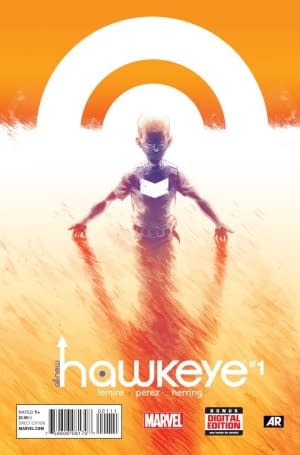
We open on a lushly nostalgic depiction of small-town Iowa, set "THEN." Not surprisingly, the idyllic picture belies darkness beneath: this is the childhood of the Barton boys, and the seeds of Clint and Barney's tough and scrapping lives ahead are sown in their attempts to avoid the wrath of a drunken foster father. In contrast to the densely-packed Hawkeye of Fraction and Aja/Annie Wu, Lemire and Perez take an expansive approach, eschewing conventional paneling for full pages of sections that blend into each other, in gorgeous, flowing storytelling. As beautiful as it is, this section is barely more than table-setting: the abusive father figure is a pretty familiar trope in the modern hero's journey, and I wonder if it's really going to do much to illuminate these characters that we already know pretty well.
After four pages, the story abruptly switches gears to "NOW," and I doubt I'm the only person that flipped ahead to the credits to see if I'd overlooked a second artist handling this modern-day section; in fact, it's Perez, pulling one of the more impressive about-faces I've seen recently, as this quippy, zippy Clint 'n' Kate caper looks and reads right out of the Fraction/Aja playbook (Perez reunites with his Tale of Sand colorist Ian Herring for this section).
The modern and flashback sections alternate, then come together with a pair of discoveries that will drive the rest of the five-issue arc (and possibly beyond); as impressive as the discrete parts of the story have been, this blending of the two is sequential storytelling of the highest order: like an operatic quartet, it conveys parallel messages in ways that are completely unique to its medium.
The first issue of All-New Hawkeye is an absolute knockout, and I'm definitely onboard with the new team as long as they can stay together (see: Edmondson and Noto on Black Widow, now 18 uninterrupted issues and counting). Given the quality of the work, I think it's safe to assume they have more up their sleeves than revisiting tropes about youthful hard times, and/or reliving the "Hawkguy" days of the previous regime: I'm anxious to see them get to it.
Jeb D. is as surprised as anyone else that this week turned out so Marvel-heavy. He's also a week behind on "Fortitude," so no spoilers, please.










